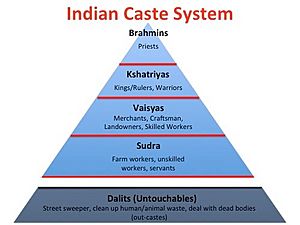Caste facts for kids
The caste system is a way of organizing people into different groups. It was mainly used in India by Hindus. This system started a long time ago as a way to divide jobs. But over time, it became a system of social class based on the family you were born into.
This system was generally accepted for about 3,000 years. It decided who people could marry, where they lived, and what jobs they did. Today, the Indian government is working to stop this kind of discrimination. For example, they set special rules for government jobs in 1950 to help people from all backgrounds.
Main Caste Groups
In India, there were four main caste groups. There was also a group called the "Untouchables." This system also spread to other parts of South Asia about 2,000 years ago.
Here are the main groups:
- Brahmins: These were the priests and teachers. They were seen as the most learned group.
- Kshatriyas or Rajanyas: These were the warriors, rulers, and kings. Their job was to protect society.
- Vaishyas: This group included merchants, craftsmen, landowners, and skilled workers. They were often involved in trade and farming.
- Shudras: These were farm workers, unskilled workers, and servants. They often supported the other groups.
The Dalits
The "Untouchables" or Dalits came much later than the other four groups. They were people who did jobs that were considered "dirty" or impure. This included tasks like sweeping ashes after cremations or handling animal waste. They faced a lot of unfair treatment.
Images for kids
-
The Basor weaving bamboo baskets in a 1916 book. The Basor are a Scheduled Caste found in the state of Uttar Pradesh in India.
-
An image of a man and woman from the toddy-tapping community in Malabar from the manuscript Seventy-two Specimens of Castes in India, which consists of 72 full-color hand-painted images of men and women of various religions, occupations and ethnic groups found in Madura, India in 1837, which confirms the popular perception and nature of caste as Jati, before the British colonial authorities made it applicable only to Hindus grouped under the varna categories from the 1901 census onwards.
-
A Sudra caste man from Bali. Photo from 1870, courtesy of Tropenmuseum, Netherlands.
-
A Tagalog royal couple (maginoo), from the Boxer Codex (c. 1590)
-
A Griot, who have been described as an endogamous caste of West Africa who specialise in oral story telling and culture preservation. They have been also referred to as the bard caste.
See also
 In Spanish: Casta para niños
In Spanish: Casta para niños









